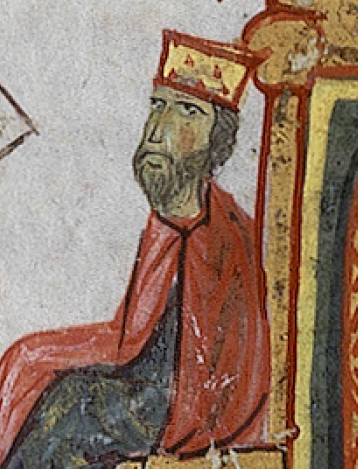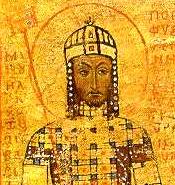|
Andronikos Doukas Angelos
Andronikos Doukas Angelos ( el, Ἀνδρόνικος Δούκας Ἄγγελος, – before 1185) was a Byzantine aristocrat related to the ruling Komnenos dynasty. During the reign of his cousin, Manuel I Komnenos, he served without success as a military commander against the Seljuk Turks, and as envoy to the Kingdom of Jerusalem. Following Manuel's death, in 1182 he was sent to stop the rebellion of Andronikos I Komnenos, but was defeated and eventually defected to him. Shortly after, he led a failed conspiracy of leading aristocrats against AndronikosI. When it was discovered, Andronikos and his sons fled the Empire, ending up in Acre, where he died. He was the father of emperors Isaac II Angelos and Alexios III Angelos. Life Andronikos was born around 1133, the third son of Constantine Angelos and Theodora Komnene, the youngest daughter of Emperor Alexios I Komnenos () and Irene Doukaina. Some time before 1155, probably around 1150, he married Euphrosyne Kas ... [...More Info...] [...Related Items...] OR: [Wikipedia] [Google] [Baidu] |
Constantinople
la, Constantinopolis ota, قسطنطينيه , alternate_name = Byzantion (earlier Greek name), Nova Roma ("New Rome"), Miklagard/Miklagarth (Old Norse), Tsargrad ( Slavic), Qustantiniya ( Arabic), Basileuousa ("Queen of Cities"), Megalopolis ("the Great City"), Πόλις ("the City"), Kostantiniyye or Konstantinopolis ( Turkish) , image = Byzantine Constantinople-en.png , alt = , caption = Map of Constantinople in the Byzantine period, corresponding to the modern-day Fatih district of Istanbul , map_type = Istanbul#Turkey Marmara#Turkey , map_alt = A map of Byzantine Istanbul. , map_size = 275 , map_caption = Constantinople was founded on the former site of the Greek colony of Byzantion, which today is known as Istanbul in Turkey. , coordinates = , location = Fatih, İstanbul, Turkey , region = Marmara Region , type = Imperial city , part_of = , length = , width ... [...More Info...] [...Related Items...] OR: [Wikipedia] [Google] [Baidu] |
Manuel I Comnenus
Manuel I Komnenos ( el, Μανουήλ Κομνηνός, translit=Manouíl Komnenos, translit-std=ISO; 28 November 1118 – 24 September 1180), Latinized Comnenus, also called Porphyrogennetos (; " born in the purple"), was a Byzantine emperor of the 12th century who reigned over a crucial turning point in the history of Byzantium and the Mediterranean. His reign saw the last flowering of the Komnenian restoration, during which the Byzantine Empire had seen a resurgence of its military and economic power and had enjoyed a cultural revival. Eager to restore his empire to its past glories as the superpower of the Mediterranean world, Manuel pursued an energetic and ambitious foreign policy. In the process he made alliances with Pope Adrian IV and the resurgent West. He invaded the Norman Kingdom of Sicily, although unsuccessfully, being the last Eastern Roman emperor to attempt reconquests in the western Mediterranean. The passage of the potentially dangerous Second Crusade thr ... [...More Info...] [...Related Items...] OR: [Wikipedia] [Google] [Baidu] |
Phrygia
In classical antiquity, Phrygia ( ; grc, Φρυγία, ''Phrygía'' ) was a kingdom in the west central part of Anatolia, in what is now Asian Turkey, centered on the Sangarios River. After its conquest, it became a region of the great empires of the time. Stories of the heroic age of Greek mythology tell of several legendary Phrygian kings: * Gordias, whose Gordian Knot would later be cut by Alexander the Great * Midas, who turned whatever he touched to gold * Mygdon, who warred with the Amazons According to Homer's ''Iliad'', the Phrygians participated in the Trojan War as close allies of the Trojans, fighting against the Achaeans. Phrygian power reached its peak in the late 8th century BC under another, historical, king Midas, who dominated most of western and central Anatolia and rivaled Assyria and Urartu for power in eastern Anatolia. This later Midas was, however, also the last independent king of Phrygia before Cimmerians sacked the Phrygian capit ... [...More Info...] [...Related Items...] OR: [Wikipedia] [Google] [Baidu] |
George Sinaites
George may refer to: People * George (given name) * George (surname) * George (singer), American-Canadian singer George Nozuka, known by the mononym George * George Washington, First President of the United States * George W. Bush, 43rd President of the United States * George H. W. Bush, 41st President of the United States * George V, King of Great Britain, Ireland, the British Dominions and Emperor of India from 1910-1936 * George VI, King of Great Britain, Ireland, the British Dominions and Emperor of India from 1936-1952 * Prince George of Wales * George Papagheorghe also known as Jorge / GEØRGE * George, stage name of Giorgio Moroder * George Harrison, an English musician and singer-songwriter Places South Africa * George, Western Cape ** George Airport United States * George, Iowa * George, Missouri * George, Washington * George County, Mississippi * George Air Force Base, a former U.S. Air Force base located in California Characters * George (Peppa Pig), a 2-year-old ... [...More Info...] [...Related Items...] OR: [Wikipedia] [Google] [Baidu] |
John Doukas (megas Hetaireiarches)
John Doukas ( gr, Ἰωάννης Δούκας, Iōannēs Doúkas; ) was a senior Byzantine military commander and diplomat under Manuel I Komnenos, serving in Italy, Hungary, Asia Minor, and the Holy Land. He rose to the rank of ''sebastos'' and the office of '' megas hetaireiarches''. Several of his seals bearing these titles are extant. Demetrios Polemis erroneously identified him with his contemporary, the Eparch of the City John Kamateros, as "John Doukas Kamateros". This has been corrected by other scholars since. Patricia Karlin-Hayter notably decomposed Polemis' composite figure into six or seven different people, of which John Doukas was assigned the bulk of the military and diplomatic career of Polemis' figure. The first activity which can be more or less securely attributed to John Doukas is an embassy to the Holy Roman Emperor Frederick I Barbarossa in 1155/6, followed by his stay in Italy. He then commanded an expedition in Dalmatia in 1164, and against the Hungarian ... [...More Info...] [...Related Items...] OR: [Wikipedia] [Google] [Baidu] |
Megas Hetaireiarches
The ( grc-gre, ἑταιρειάρχης), sometimes anglicized as Hetaeriarch, was a high-ranking Byzantine officer, in command of the imperial bodyguard, the . In the 9th–10th centuries there appear to have been several , each for one of the subdivisions of the , but in later times only the senior of them, the ( grc-gre, μέγας ἑταιρειάρχης) or Great Hetaeriarch survived, eventually becoming simply a high court rank in the 12th–15th centuries. History The Imperial (, ) was a bodyguard regiment of the Byzantine emperors in the 9th–11th centuries, originally recruited mainly from among foreigners. It is first mentioned in 812, as a bodyguard for the emperor on campaign, but its origin is obscure. The Imperial of the 9th–10th centuries was divided in several units: three or four according to the sources, distinguished by their epithets and each, at least originally, under is respective . Thus the commanded the 'Great ' (, ). He was the senior of the mil ... [...More Info...] [...Related Items...] OR: [Wikipedia] [Google] [Baidu] |
Battle Of Myriokephalon
The Battle of Myriokephalon (also known as the Battle of Myriocephalum, gr, Μάχη του Μυριοκέφαλου, tr, Miryokefalon Savaşı or ''Düzbel Muharebesi'') was a battle between the Byzantine Empire and the Seljuk Turks in Phrygia in the vicinity of Lake Beyşehir in southwestern Turkey on 17 September 1176. The battle was a strategic reverse for the Byzantine forces, who were ambushed when moving through a mountain pass. It was to be the final, unsuccessful effort by the Byzantines to recover the interior of Anatolia from the Seljuk Turks. Background Between 1158 and 1161 a series of Byzantine campaigns against the Seljuk Turks of the Sultanate of Rûm resulted in a treaty favourable to the Empire, with the sultan recognising a form of subordination to the Byzantine emperor. Immediately after peace was negotiated the Seljuk sultan Kilij Arslan II visited Constantinople where he was treated by Emperor Manuel I Komnenos as both an honoured guest and an imperial va ... [...More Info...] [...Related Items...] OR: [Wikipedia] [Google] [Baidu] |
Sultanate Of Iconium
fa, سلجوقیان روم () , status = , government_type = Hereditary monarchyTriarchy (1249–1254)Diarchy (1257–1262) , year_start = 1077 , year_end = 1308 , p1 = Byzantine Empire under the Doukas dynastyByzantine Empire , p2 = Seljuk Empire , p3 = Danishmends , p4 = Mengujekids , p5 = Saltukids , p6 = Artuqids , s1 = Anatolian beyliks , s2 = Ilkhanate, , event_pre = Battle of Manzikert , date_pre = 1071 , event_start = Division from the Seljuk Empire , event1 = Battle of Köse Dağ , date_event1 = 1243 , event_end = Karamanid conquest , image_flag = Double-headed eagle of the Sultanate of Rum.svg , flag_size = 100px , flag_type = ... [...More Info...] [...Related Items...] OR: [Wikipedia] [Google] [Baidu] |
Synod
A synod () is a council of a Christian denomination, usually convened to decide an issue of doctrine, administration or application. The word '' synod'' comes from the meaning "assembly" or "meeting" and is analogous with the Latin word meaning "council". Originally, synods were meetings of bishops, and the word is still used in that sense in Catholicism, Oriental Orthodoxy and Eastern Orthodoxy. In modern usage, the word often refers to the governing body of a particular church, whether its members are meeting or not. It is also sometimes used to refer to a church that is governed by a synod. Sometimes the phrase "general synod" or "general council" refers to an ecumenical council. The word ''synod'' also refers to the standing council of high-ranking bishops governing some of the autocephalous Eastern Orthodox churches. Similarly, the day-to-day governance of patriarchal and major archiepiscopal Eastern Catholic Churches is entrusted to a permanent synod. Usages i ... [...More Info...] [...Related Items...] OR: [Wikipedia] [Google] [Baidu] |
Theodore Kastamonites
Theodore Kastamonites ( gr, Θεόδωρος Κασταμονίτης) was a Byzantine aristocrat and the all-powerful chief minister for most of the first reign of his nephew, Emperor Isaac II Angelos. Life The Kastamonites family probably hailed from Kastamon in Paphlagonia, and had emerged in the late 11th century as one of the Byzantine Empire's aristocratic clans, its members holding various civil and military offices under the Komnenian emperors. Theodore was the brother of Euphrosyne Kastamonitissa, wife of Andronikos Doukas Angelos and mother of the emperors Isaac II Angelos () and Alexios III Angelos (). When Isaac II ascended the throne, he was unable to rely on the support of the restive and ambitious noble families, and turned to the bureaucracy for support. Immediately after his accession, Isaac II placed his uncle in charge of the financial administration. Although suffering from gout so that he had to be carried about in a litter, according to his contemporary Nike ... [...More Info...] [...Related Items...] OR: [Wikipedia] [Google] [Baidu] |






